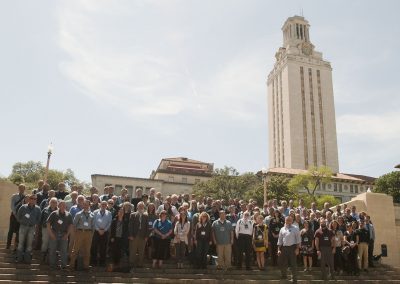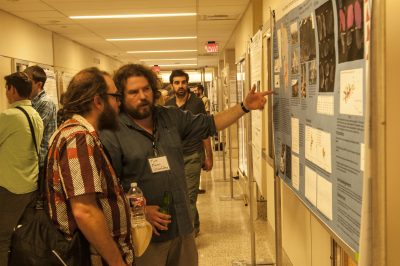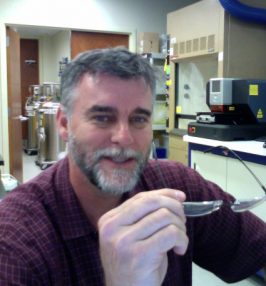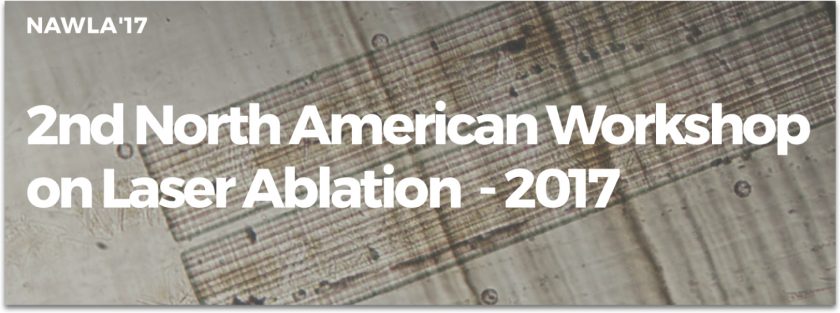Jackson School Hosts International Laser Ablation Meeting
June 23, 2017
A who’s who of laser ablation and inductively coupled plasma mass spectrometry converged on Austin in May to share knowledge about this powerful analytical technology.
The meeting – the North American Workshop on Laser Ablation – was also the second time the group has come to The University of Texas at Austin Jackson School of Geosciences. The three-day workshop was spearheaded by a small group that includes Jackson School Laser Ablation and ICP-MS Lab Manager Nate Miller, who wanted to help create a workshop environment where scientists and instrument vendors could exchange information about a rapidly changing field.
“The best way to learn something is from an expert, and very few of us get the chance to go visit an expert in a lab to learn a technique,” he said. “We’re trying create a workshop with shared experiences and opportunities where you can learn.”

The workshop constituted a snap shot of state-of-the-art laser ablation research. Some 130 scientists and vendors from 12 countries attended the workshop, including two internationally known pioneers in the field: Sam Houk of Iowa State University and Henry Longerich of Memorial University of Newfoundland. Jackson School research was presented by professors Richard Kyle and Daniel Stockli, postdoctoral fellow Federico Galster, and graduate students Stephanie Wafforn and Kylie Wright.
Laser ablation is often combined with inductively coupled plasma mass spectrometry (LA-ICP-MS), to perform highly sensitive elemental and isotopic analysis directly on solid samples. To do so, a laser ablates, or photomechanically generates, tiny particles from the surface of a sample. The particles are then transported to an ICP-MS instrument where they are converted to ions using plasma and then analyzed for elemental and isotopic makeup.
The process was invented nearly 40 years ago by the U.S. Department of Energy’s Ames Laboratory at Iowa State University. Originally, the technique was used largely by geologists and environmental scientists, but it has since been adopted by a number of fields, including medicine and others that test biological samples, archaeology, mining, manufacturing, and forensics. Among the scientific applications presented at the workshop were mapping elemental growth variations in shark vertebrae to help assess migration patterns, sampling plant leaves and tree rings to analyze nutrients and carbon isotope compositions, and analyzing electrical tape compositions for forensic criminal investigations.
Houk who helped build the first ICP-MS instrument as a graduate student at Iowa State in 1978, said it is “remarkable, but not surprising” how many fields now

use the technique given how fast and powerful the analytical tool is. He pointed out that laser ablation and/or ICP-MS have been used for a wide array of reasons over the years, including tracking rogue nuclear weapons programs and testing for lead in water and blood in Flint, Michigan.
Even with his decades in the field, Houk, who is now a professor at Iowa State specializing in analytical spectroscopy and inorganic mass spectrometry, said he was struck by some of the amazing advances demonstrated at the workshop.
“There is of course a lot of work in improving the instrumentation,” he said. “In a recent talk they were down to one micrometer spatial resolution, which is smaller than an individual biological cell. That’s really quite remarkable.”
Henry Longerich’s lab bought their first ICP-MS instrument in 1984, which was the tenth commercial instrument sold by SCIEX. Later, in 1989 they built a laser ablation sample introduction system to use with the ICP-MS instrument.
“The exciting thing to me in the beginning was that it was something totally new and had so many fantastic capabilities,” he said. “It has revolutionized so many things.”
Miller was particularly impressed with some of the developments in LA-ICP-MS he saw presented at the workshop.
“There are time of flight ICP-MS instruments that measure the travel times of ions,” he said. “They can measure a complete mass spectrum in 30 µs. That’s every mass on the periodic table in 30-millionths of a second.”
Because this detection method is so fast, it is practical to make high-resolution 2-D maps of samples by rapid rastering of the laser while the laser fires at a high repetition rate.

“They are actually making pictures from individual laser pulses, while the laser is firing at 100 times per second and scanning over the surface at 200 microns per second,” Miller said.
Pixel sizes in the range of 5-10 micro meters are becoming common. The images are analogous to electron microprobe element maps, but with much lower detection limits. Another instrumentation breakthrough is the addition of a second quadrupole mass filter in front of a collision-reaction cell and analyzing quadrupole. The upshot of this is that many common mass interferences can be effectively eliminated. For example 204Hg can be excluded when measuring 204Pb, and 176Yb and 176Lu can be excluded when measuring 176Hf. When you add laser ablation as a sampling tool, this opens up new research opportunities for the geosciences – for example in situ Rb-Sr dating of potassium-bearing minerals in metamorphic and igneous systems, single element thermobarometry, and low-level S analysis in stalagmites and ice cores.
The workshop is now being held every other year – on the off-years of the long-running European workshop on the same topic. Miller doesn’t know yet if the Jackson School will be the permanent home of the event, but said that the group is committed to keeping the meeting going. That’s good news for Longerich, who said he found the workshop much more constructive than some larger and better-known scientific conferences.
“It’s a perfect size,” Longerich said of the workshop. “That makes this meeting, for me, more productive. I can just sit there and soak it all in.”

